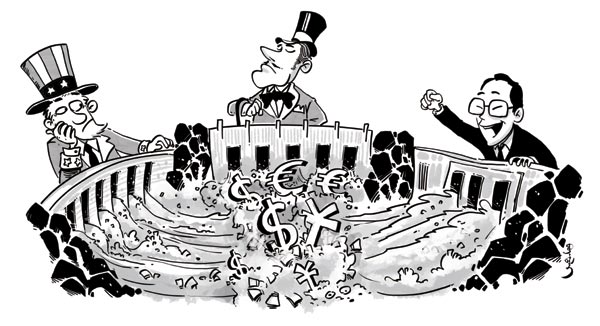|
 |
|
CAI MENG/CHINA DAILY |
Predictably, the European Central Bank has joined the world's other major monetary authorities in the greatest experiment in the history of central banking. By now, the pattern is all too familiar. First, central banks take the conventional policy rate down to the dreaded "zero bound". Facing continued economic weakness, but having run out of conventional tools, they then embrace the unconventional approach of quantitative easing (QE).
The theory behind this strategy is simple: Unable to cut the price of credit further, central banks shift their focus to expanding its quantity. The implicit argument is that this move from price to quantity adjustments is the functional equivalent of additional monetary policy easing. Thus, even at the zero bound of nominal interest rates, it is argued, central banks still have weapons in their arsenal.
But are those weapons up to the task? For the ECB and the Bank of Japan, both of which are facing formidable downside risks to their economies and aggregate price levels, this is hardly an idle question. For the United States, where the ultimate consequences of QE remain to be seen, the answer is just as consequential.
In terms of transmission, the US Federal Reserve has focused on the so-called wealth effect. First, the balance sheet expansion of some $3.6 trillion since late 2008-which far exceeded the $2.5 trillion in nominal GDP growth over the QE period-boosted asset markets. It was assumed that the improvement in investors' portfolio performance-reflected in a more than threefold rise in the S&P 500 from its crisis-induced low in March 2009-would spur a burst of spending by increasingly wealthy consumers. The BOJ has used a similar justification for its own policy of quantitative and qualitative easing (QQE).
The ECB, however, will have a harder time making the case for wealth effects, largely because equity ownership by individuals (either direct or through their pension accounts) is far lower in Europe than in the US or Japan. For Europe, monetary policy seems more likely to be transmitted through banks, as well as through the currency channel, as a weaker euro-it has fallen some 15 percent against the US dollar over the last year-boosts exports.
The real sticking point for QE relates to traction. The US, where consumption accounts for the bulk of the shortfall in the post-crisis recovery, is a case in point. In an environment of excess debt and inadequate savings, wealth effects have done very little to ameliorate the balance sheet recession that clobbered US households when the property and credit bubbles burst. Indeed, annualized real consumption growth has averaged just 1.3 percent since early 2008. With the current recovery in real GDP on a trajectory of 2.3 percent annual growth-2 percentage points below the norm of past cycles-it is tough to justify the widespread praise of QE.
Japan's massive QQE campaign has faced similar traction problems. After expanding its balance sheet to nearly 60 percent of GDP-double the size of the Fed's-the BOJ is finding that its campaign to end deflation is increasingly ineffective. Japan has lapsed back into recession, and the BOJ has just cut the inflation target for this year from 1.7 percent to 1 percent.
Finally, QE also disappoints in terms of time consistency. The Fed has long qualified its post-QE normalization strategy with a host of data-dependent conditions pertaining to the state of the economy and/or inflation risks. Moreover, it is now relying on ambiguous adjectives to provide guidance to financial markets, having recently shifted from stating that it would maintain low rates for a "considerable" time to pledging to be "patient" in determining when to raise rates.
In the QE era, monetary policy has lost any semblance of discipline and coherence. As ECB President Mario Draghi attempts to deliver on his nearly two-and-a-half-year-old commitment, the limits of his promise-like comparable assurances by the Fed and the BOJ-could become glaringly apparent. Like lemmings at the cliff's edge, central banks seem steeped in denial of the risks they face.
The author is a faculty member at Yale University and former chairman of Morgan Stanley Asia. Project Syndicate
